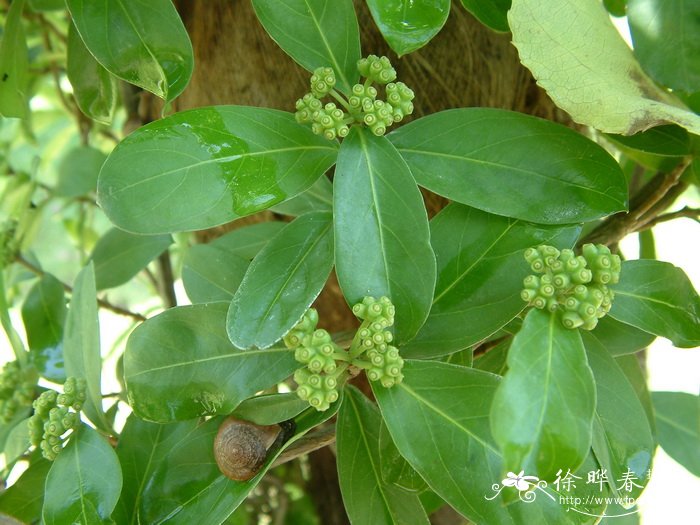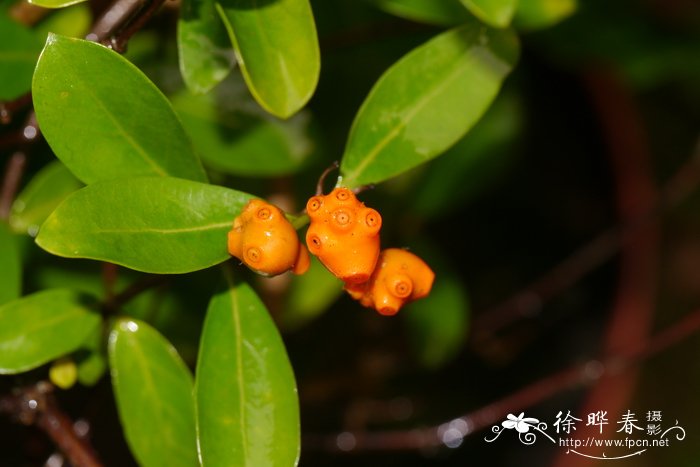巴戟天Morinda officinalis
中文名(Chinese Name):巴戟天
学名(Scientific Name):Morinda officinalis How
英文名(English Common Name):
别名(Chinese Common Name):大巴戟
异名(Synonym):
科属(Family & Genus):茜草科(Rubiaceae)巴戟天属
形态特征(Description):藤本;肉质根不定位肠状缢缩,根肉略紫红色,干后紫蓝色;嫩枝被长短不一粗毛,后脱落变粗糙,老枝无毛,具棱,棕色或蓝黑色。叶薄或稍厚,纸质,干后棕色,长圆形,卵状长圆形或倒卵状长圆形,长6-13厘米,宽3-6厘米,顶端急尖或具小短尖,基部纯、圆或楔形,边全缘,有时具稀疏短缘毛,上面初时被稀疏、紧贴长粗毛,后变无毛,中脉线状隆起,多少被刺状硬毛或弯毛,下面无毛或中脉处被疏短粗毛;侧脉每边(4-)5-7条,弯拱向上,在边缘或近边缘处相联接,网脉明显或不明显;叶柄长4-11毫米,下面密被短粗毛;托叶长3-5毫米,顶部截平,干膜质,易碎落。花序3-7伞形排列于枝顶;花序梗长5-10毫米,被短柔毛,基部常具卵形或线形总苞片1;头状花序具花4-10朵;花(2-)3(-4)基数,无花梗;花萼倒圆锥状,下部与邻近花萼合生,顶部具波状齿2-3,外侧一齿特大,三角状披针形,顶尖或钝,其余齿极小;花冠白色,近钟状,稍肉质,长6-7毫米,冠管长3-4毫米,顶部收狭而呈壶状,檐部通常3裂,有时4或2裂,裂片卵形或长圆形,顶部向外隆起,向内钩状弯折,外面被疏短毛,内面中部以下至喉部密被髯毛;雄蕊与花冠裂片同数,着生于裂片侧基部,花丝极短,花药背着,长约2毫米;花柱外伸,柱头长圆形或花柱内藏,柱头不膨大,2等裂或2不等裂,子房(2-)3(-4)室,每室胚珠1颗,着生于隔膜下部。聚花核果由多花或单花发育而成,熟时红色,扁球形或近球形,直径5-11毫米;核果具分核(2-)3(-4);分核三棱形,外侧弯拱,被毛状物,内面具种子1,果柄极短;种子熟时黑色,略呈三棱形,无毛。花期5-7月,果熟期10-11月。
分布(Distribution):产福建、广东、海南、广西,生于山地疏、密林下和灌丛中,常攀于灌木或树干上。中南半岛也有分布。
用途(Use):本种是现代中药巴戟天的原植物,其肉质根的根肉晒干即成药材“巴戟天”。
引自中国植物志英文版:FOC Vol. 19 Page 221, 226
Morinda officinalis F. C. How, Acta Phytotax. Sin. 7: 326. 1958.
巴戟天 ba ji tian| Rubiaceae | Morinda
Lianas; branches surrounded at base by persistent leafless stipules, when young strigillose, hirtellous, or pilose, becoming glabrescent and scabrous, angled, brown or bluish black. Leaves opposite; petiole 4-11 mm, densely puberulent, strigillose, hirtellous, or hirsute to glabrescent; blade drying papery, on both surfaces brown to yellow-brown, shiny to matte adaxially, matte abaxially, ovate-oblong, obovate-oblong, or elliptic, 6-13 × 3-6 cm, adaxially sparsely strigillose, hirtellous, or hirsute to glabrescent, abaxially glabrous or sparsely hirtellous along principal veins, base obtuse, rounded, cuneate, or acute, apex acute, obtuse, or rounded and abruptly mucronulate; secondary veins (4 or)5-7 pairs, with small pilosulous domatia; stipules fused into a spathe or tube, 3-5 mm, membranous, puberulent to hirtellous, truncate, on each side 2-denticulate. Inflorescence terminal; peduncles 1-7 or 15-25, umbellate or fasciculate, 0.1-1 cm, densely hirtellous to strigillose, as a group usually subtended by 1 or 2 stipuliform bracts; heads 1 per peduncle, subglobose to hemispherical, 5-7 mm in diam., 1-3- or 4-10-flowered. Flowers fused for ca. half of hypanthium, biology not noted. Calyx puberulent to glabrous; limb 1-1.5 mm, lobed for ca. 1/2; lobes 2-4, triangular, sometimes markedly unequal on an individual flower, obtuse to acute. Corolla white, campanulate or urceolate, outside puberulent, hirtellous, or glabrescent; tube 3-4 mm, inside densely villosulous from middle of tube to throat; lobes (2-)4, lanceolate or narrowly oblong, 3-4 mm, apically thickened and rostrate. Drupecetum globose to oblate, 5-11 mm in diam. Drupes fully fused, red, subglobose, 4-5 mm. Fl. May-Jul, fr. Oct-Nov.
● Sparse or dense forests and thickets on mountains, also cultivated; 100-500 m. Fujian, Guangdong, Guangxi, Hainan.
According to the protologue, the species is apparently cultivated and used medicinally. The roots were described by Y. Z. Ruan (in FRPS 71(2): 199. 1999) as fleshy, irregularly intestine-like constricted, slightly purplish red, purplish blue when dry; they are illustrated in the protologue figure. The roots of almost no other Morinda species have been described by Y. Z. Ruan or any other authors seen.


(责任编辑:徐晔春)
学名(Scientific Name):Morinda officinalis How
英文名(English Common Name):
别名(Chinese Common Name):大巴戟
异名(Synonym):
科属(Family & Genus):茜草科(Rubiaceae)巴戟天属
形态特征(Description):藤本;肉质根不定位肠状缢缩,根肉略紫红色,干后紫蓝色;嫩枝被长短不一粗毛,后脱落变粗糙,老枝无毛,具棱,棕色或蓝黑色。叶薄或稍厚,纸质,干后棕色,长圆形,卵状长圆形或倒卵状长圆形,长6-13厘米,宽3-6厘米,顶端急尖或具小短尖,基部纯、圆或楔形,边全缘,有时具稀疏短缘毛,上面初时被稀疏、紧贴长粗毛,后变无毛,中脉线状隆起,多少被刺状硬毛或弯毛,下面无毛或中脉处被疏短粗毛;侧脉每边(4-)5-7条,弯拱向上,在边缘或近边缘处相联接,网脉明显或不明显;叶柄长4-11毫米,下面密被短粗毛;托叶长3-5毫米,顶部截平,干膜质,易碎落。花序3-7伞形排列于枝顶;花序梗长5-10毫米,被短柔毛,基部常具卵形或线形总苞片1;头状花序具花4-10朵;花(2-)3(-4)基数,无花梗;花萼倒圆锥状,下部与邻近花萼合生,顶部具波状齿2-3,外侧一齿特大,三角状披针形,顶尖或钝,其余齿极小;花冠白色,近钟状,稍肉质,长6-7毫米,冠管长3-4毫米,顶部收狭而呈壶状,檐部通常3裂,有时4或2裂,裂片卵形或长圆形,顶部向外隆起,向内钩状弯折,外面被疏短毛,内面中部以下至喉部密被髯毛;雄蕊与花冠裂片同数,着生于裂片侧基部,花丝极短,花药背着,长约2毫米;花柱外伸,柱头长圆形或花柱内藏,柱头不膨大,2等裂或2不等裂,子房(2-)3(-4)室,每室胚珠1颗,着生于隔膜下部。聚花核果由多花或单花发育而成,熟时红色,扁球形或近球形,直径5-11毫米;核果具分核(2-)3(-4);分核三棱形,外侧弯拱,被毛状物,内面具种子1,果柄极短;种子熟时黑色,略呈三棱形,无毛。花期5-7月,果熟期10-11月。
分布(Distribution):产福建、广东、海南、广西,生于山地疏、密林下和灌丛中,常攀于灌木或树干上。中南半岛也有分布。
用途(Use):本种是现代中药巴戟天的原植物,其肉质根的根肉晒干即成药材“巴戟天”。
引自中国植物志英文版:FOC Vol. 19 Page 221, 226
Morinda officinalis F. C. How, Acta Phytotax. Sin. 7: 326. 1958.
巴戟天 ba ji tian| Rubiaceae | Morinda
Lianas; branches surrounded at base by persistent leafless stipules, when young strigillose, hirtellous, or pilose, becoming glabrescent and scabrous, angled, brown or bluish black. Leaves opposite; petiole 4-11 mm, densely puberulent, strigillose, hirtellous, or hirsute to glabrescent; blade drying papery, on both surfaces brown to yellow-brown, shiny to matte adaxially, matte abaxially, ovate-oblong, obovate-oblong, or elliptic, 6-13 × 3-6 cm, adaxially sparsely strigillose, hirtellous, or hirsute to glabrescent, abaxially glabrous or sparsely hirtellous along principal veins, base obtuse, rounded, cuneate, or acute, apex acute, obtuse, or rounded and abruptly mucronulate; secondary veins (4 or)5-7 pairs, with small pilosulous domatia; stipules fused into a spathe or tube, 3-5 mm, membranous, puberulent to hirtellous, truncate, on each side 2-denticulate. Inflorescence terminal; peduncles 1-7 or 15-25, umbellate or fasciculate, 0.1-1 cm, densely hirtellous to strigillose, as a group usually subtended by 1 or 2 stipuliform bracts; heads 1 per peduncle, subglobose to hemispherical, 5-7 mm in diam., 1-3- or 4-10-flowered. Flowers fused for ca. half of hypanthium, biology not noted. Calyx puberulent to glabrous; limb 1-1.5 mm, lobed for ca. 1/2; lobes 2-4, triangular, sometimes markedly unequal on an individual flower, obtuse to acute. Corolla white, campanulate or urceolate, outside puberulent, hirtellous, or glabrescent; tube 3-4 mm, inside densely villosulous from middle of tube to throat; lobes (2-)4, lanceolate or narrowly oblong, 3-4 mm, apically thickened and rostrate. Drupecetum globose to oblate, 5-11 mm in diam. Drupes fully fused, red, subglobose, 4-5 mm. Fl. May-Jul, fr. Oct-Nov.
● Sparse or dense forests and thickets on mountains, also cultivated; 100-500 m. Fujian, Guangdong, Guangxi, Hainan.
According to the protologue, the species is apparently cultivated and used medicinally. The roots were described by Y. Z. Ruan (in FRPS 71(2): 199. 1999) as fleshy, irregularly intestine-like constricted, slightly purplish red, purplish blue when dry; they are illustrated in the protologue figure. The roots of almost no other Morinda species have been described by Y. Z. Ruan or any other authors seen.
(责任编辑:徐晔春)
踩一下[0]

顶一下[2]